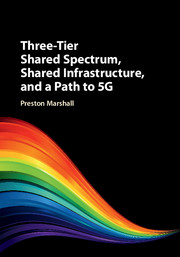Book contents
- Frontmatter
- Contents
- Acknowledgments
- Preface
- Part I Spectrum Sharing Background
- Part II Three-Tier Dynamic Spectrum Models
- Part III Components of a Three-Tier Architecture
- Part IV Protection Processes for Incumbents and Peers
- Part V Example Use of Three-Tier Spectrum: Use of the 3.5 GHz CBRS Band in the USA
- Part VI Future Bands, Network Services, Business Models, and Technology
- 15 Potential Services and Business Models Enabled by Three-Tier Spectrum
- 16 Candidate Incumbent Bands for Three-Tier Spectrum Sharing
- 17 From Shared Spectrum, to Shared Infrastructure, to a New Model of 5G
- 18 Future Actions to Deploy More Three-Tier Spectrum Bands and Nations
- 19 Alternatives to Three-Tier Operation
- 20 Conclusions and a Look Ahead
- Part VII Appendices
- Index
- References
18 - Future Actions to Deploy More Three-Tier Spectrum Bands and Nations
from Part VI - Future Bands, Network Services, Business Models, and Technology
Published online by Cambridge University Press: 30 August 2017
- Frontmatter
- Contents
- Acknowledgments
- Preface
- Part I Spectrum Sharing Background
- Part II Three-Tier Dynamic Spectrum Models
- Part III Components of a Three-Tier Architecture
- Part IV Protection Processes for Incumbents and Peers
- Part V Example Use of Three-Tier Spectrum: Use of the 3.5 GHz CBRS Band in the USA
- Part VI Future Bands, Network Services, Business Models, and Technology
- 15 Potential Services and Business Models Enabled by Three-Tier Spectrum
- 16 Candidate Incumbent Bands for Three-Tier Spectrum Sharing
- 17 From Shared Spectrum, to Shared Infrastructure, to a New Model of 5G
- 18 Future Actions to Deploy More Three-Tier Spectrum Bands and Nations
- 19 Alternatives to Three-Tier Operation
- 20 Conclusions and a Look Ahead
- Part VII Appendices
- Index
- References
Summary
Issues for International Expansion
It might be considered that spectrum policies are developed through a common process that is similar throughout the world, and standardized. However, spectrum policies have generally followed one of two alternative paths in their development and implementation:
ITU Down An International Telecommunication Union (ITU)-Down strategy focuses on achieving international, or at least ITU regional, acceptance of establishing three-tier spectrum policies. The process of achieving agreement at the periodic World Radio Conference (WRC) events is at least a long process. It typically addresses band-specific policies, rather than policies that are band-independent. And as will be discussed later, such international harmonization is not necessary for the adoption of three-tier spectrum.
Nations-Up Nation-by-nation approaches focus on developing support in typically early-adopter nations as a secondary allocation. The regulations would need to protect ITU-compliant uses, but these are typically incumbents in the band that are protected under the three-tier concept in any case. For example, in the USA, the Citizens Broadband Radio Service (CBRS) band is the extended C-Band satellite downlink. The rules protect the international activity in the band, and therefore comply with ITU treaties.
The strategy for introducing three-tier into National Regulatory Authority (NRA) regimes is significantly aided by a factor the author has referred to as “regulatory virtualization.” This provides the flexibility to adopt these regulations on a band-by-band, and nation-by-nation process that requires no coordination across borders, and can be adopted to suit localized, rather than international, needs.
Regulatory Virtualization
One of the constraints of spectrum policy has been that device manufacturers have “baked in” most of the regulatory limits imposed by national and international regimes. This has limited the flexibility of nations to manage spectrum in unique ways, since they would be forcing a fragmented market, and higher costs. They would be vulnerable to an inflow of non-conforming devices due to device purchase in other countries, as roam the world. Similarly, the rules, once established, cannot be readily updated to either restrict or open up the rights regime.
- Type
- Chapter
- Information
- Publisher: Cambridge University PressPrint publication year: 2017



